☞ PLEASE NOTE that I continue to update (edit) this post with additional information, since it has already taken me several hours to complete the main post, and for some of the plants I have much more information that will be of interest to the readers. I am able to supply seeds of some of these plants, free for the asking, to readers who wish to evaluate them on their own. How to obtain the seeds : send me a Tree-Mail with your request. You will receive your seeds by regular U.S. mail ✉ letter rate, and I will try to post the letter with a nice commemorative stamp to addresses within the U.S. For our Canadian friends I will do the same, but it will be necessary for me to put three stamps on the envelope, so they may just be the regular "forever flag stamps" but I will be glad to do it all the same ☺
_________________________________________________________
Amaranth hypochondriacus cv. 'Burgundy'
Amaranthus hypochondriacus " AMARANTH BURGUNDY "
The plant pictured here is a volunteer plant from seeds from the previous year(s) which remained viable in the soil for several years. This year I've had several of these nicely colored plants appear in my garden unexpectedly.
This is a cultivar of Amaranth hypochondriacus with burgundy-colored leaves, otherwise it is exactly the same as the typically green-leaved Amaranth hypochondriacus, which has edible leaves and seeds. Not only is it edible, but is one of the most valuable, highly nutritious and delicious plants that can be grown in your garden. The leaves (when cooked) resembles the taste of spinach so much that unless you tell your guest when serving, they may never know, but you should tell them that it is not spinach, not even related to spinach, but rivals or surpasses the nutritional value of spinach by providing a substantial quantity of an important amino acid : lysine; especially in the seeds.
The leaves can be steamed or cooked like spinach, and in the cultivar 'Burgundy' the leaves will turn green when cooked, but the leaves are perfectly edible raw, so the nice color is retained in a fresh salad mix.
The whitish straw-colored seeds can be boiled or steamed like rice, or mixed with rice or other grain and steamed together in your rice cooker. Or the seeds can be milled into flour and blended with other flours (wheat, barley, millet, etc.), or the seeds can be popped and mixed with honey to make "alegria" - a little known traditional treat that children especially love.
I have thoroughly documented Amaranth hypochondriacus with my self-published booklet in 1991, the title page posted here ☟
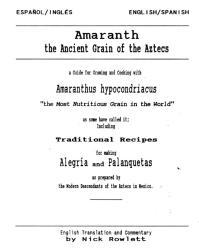
I will provide seeds of Amaranth hypochondriacus cv. 'Burgundy' free of charge, by request.

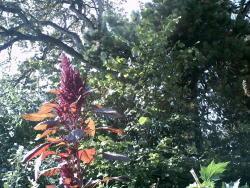
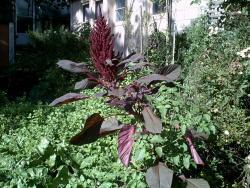
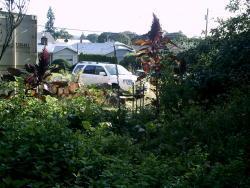
( above: Amaranth hypochondriacus cv. 'Burgundy' )
NOTES: 25 September 2019
The tallest plant in the above pics is 6½ feet tall. The second tallest is 4½ feet tall. The shortest plant is 4 feet 7 inches tall (55 inches). Remember that these plants originated as "volunteers" - sprouting this Spring on their own, and growing to this stature when these last 3 pics were taken on 25 September 2019. Extreme heat did not affect them, neither did high winds or drenching rains. They remained steadfast through all of that, and are nearing harvest now. If you want free seeds, just send me a Tree-Mail with your mailing address and I will mail them out to you ABSOLUTELY FREE of charge. This is an important food crop. The color variation is the only difference between it (cv. 'Burgundy'), and the typical green-leaf form of Amaranthus hypochondriacus.
__________________________________________________________
Agretti (Land Seaweed)
Salsola komarovi
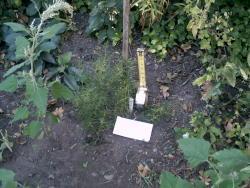
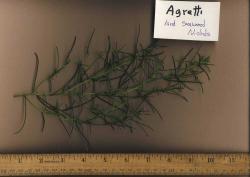
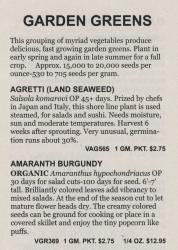
____________________________________________________
Oca
Oxalis tuberosa
This is the second year that I have grown Oca. The first year was last year, 2018, when I carefully planted the 8 small tubers that I received from Nichols Garden Nursery (address below). That first year, my harvest was many fold, so many tubers (large and small, some pink and some white) that I was able to plant all of the tubers this year in several large containers ranging in size from about 3 gallon capacity to about 6 gallon capacity, as seen here in the first pic. I have them in various locations which receive different sun exposures, ranging from quite shaded to full sun. I actually would have had more tubers to plant this year if a mouse hadn't carried some off during the Winter when I had them overwintering in a flat in the greenhouse. When I discovered that, I had to place a screen over the flat to prevent further losses. How many tubers did I harvest that first year from the original 8 that I planted? Since I was able to plant 5 large containers, and each were planted with at least 15, and possibly as many as 20 for a couple of them with the smallest tubers, I would say that my first harvest last year was around 85 or 90 tubers, ranging in size from about ¼ inch diameter to about 1½ inch diameter, and two or three tubers up to about 2 inches long maybe. That includes 5 to 10 small tubers that the mouse carried off.
They have not started to produce new tubers yet this season; that will be later in the Fall, when I hope to have enough tubers to fully evaluate with a meal or two, plus many more for replanting in 2020. They make perfect container plants; no pests have been noticed on any of them (such as aphids, slugs or snails, or any of the other usual nuisances), and other than resembling a giant form of the oxalis weed with yellow flowers (to which they are related), a very nice and happy plant.
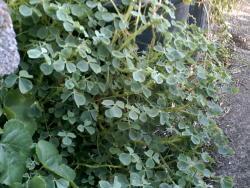
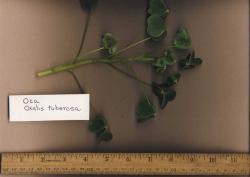
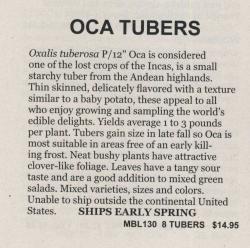
All of the above are available from :
Nichols Garden Nursery
1190 Old Salem Rd NE
Albany OR 97321
phone 1-800-422-3985
NicholsGardenNursery.com
_____________________________________________
PAPALO
Porophyllum coloratum
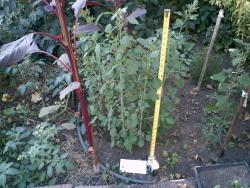

___________________________________________
PIPICHE
Porophyllum tagetoides
The plant in the background is a goosefoot cultivar which volunteered from seeds planted the previous year(s)
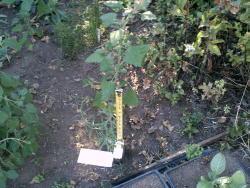

seeds of Papalo and Pipiche are available from :
Redwood City Seed Company
P.O. Box 361
Redwood City, CA 94064
phone 650-325-7333
www.ecoseeds.com
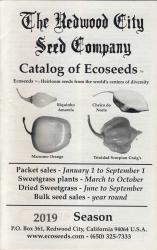

__________________________________________________
Physalis acutifolia
"wild tomatillo"
sharpleaf groundcherry / Wright's ground-cherry
I have done much research on this plant, the original seeds sent to me several years ago by username > sacredorigin - which she found growing wild in her garden in northern California. Very edible fruits when cooked, tasting very much like tomatoes. Seeds can be obtained free of charge from me upon request. This plant volunteered from plants which went to seed several years ago in the same location. Very prolific producer of tiny "husk tomatoes" / "wild tomatillos" / wild ground cherries. Search on Google Images > Physalis acutifolia
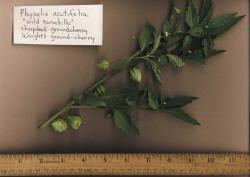
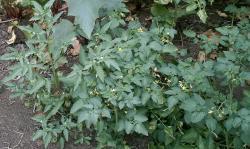
above pic: Physalis acutifolia (left) growing among several volunteer cherry tomato plants (right), some of which are almost ready to ripen.
This year I had many of these volunteer cherry tomatoes which sprung up where I had planted seeds of other plants. The other plants didn't appear, but the cherry tomatoes did, as faithful old friends, year after year, in the same location as in previous years. So these can be considered as a naturalized "citizen" of my garden domain. My gardening philosophy has become : why struggle with fussy plants that you have to baby along and protect from pests, including the neighbor's Mastiff pup who innocently traipses through the garden, likely to step on the emerging sprouts of freshly sown seeds, when these little tomatoes spring up and grow so quickly that it doesn't matter.
Would you like some seeds of these wonderful tasty little red tomatoes? Just send me a Tree-Mail with a request and they will be on their way to you, just as soon as some of them ripen, which won't be very long now. Incredibly tasty, vigorous and prolific.
_______________________________________________
Solanum americanum
American black nightshade
I have researched the edibility of the ripe fruits, beginning several years ago, but not extensively (in large quantities). ⚠ CAUTION: The green fruits and foliage should be considered poisonous ☠
The plants which I have in several locations on the property arise spontaneously from seeds which are present in the environment. I believe that the ripe fruits should be considered edible when cooked. Seeds can be obtained free of charge from me upon request.
I have used the following reference as part of my research on the edibility of the plant shown in the high resolution scan labeled below as " Solanum americanum - American black nightshade " :
__________________
Luther Burbank's "Sunberry" (aka "Wonderberry")
Burbank, Luther, 1849-1926 / Luther Burbank: his methods and discoveries and their practical application
Volume VI (1914)
[EXCERPTS QUOTED]
[page 105]
The Sunberry - A Production From the Wild
[ SOME OF THE TEXT OMITTED HERE as not relative to the subject of my research : pages 105 to 110]
[p. 110]
" The Nightshade Family - I have elsewhere referred to my interest in the members of the nightshade family, or, as the botanist calls them, The Solanaceae.
The fact that the potato, with which my first …
[p. 111]
ON THE SUNBERRY
" … experiments in plant development were made, belongs to this family would naturally give me an interest in the tribe. But I was particularly attracted also because of the diversity of characteristics among members of the family.
Here, on one hand, are the potato, the tomato, and the eggplant, ranking among our highly important garden vegetables, and the strawberry-tomato or ground cherry among the minor vegetables that have a good share of popularity; and, on the other hand, closely related species are bearers of the most powerful narcotic poisons, including belladonna and hyoscyamus, drugs that have an accepted place in the pharmacopoeia.
Add that the tobacco plant is another member of the family, and it is clear that this is one of the most curiously versatile, and, from a human standpoint, one of the most important plant tribes.
My interest in the family extended beyond the familiar plants just named, and included several species of nightshade that are chiefly known as roadside weeds and bearers of berries some of which are eaten on occasion by country folk, but which in the main have a bad reputation, some of them being accounted highly poisonous.
The name "deadly nightshade," applied to one of the most familiar species, suggests the repute in which these weeds are commonly held."
[p. 112]
"Yet it is known to the residents of some country districts, particularly in the Mississippi Valley, that the little black berries of the nightshade, if thoroughly ripe, may be made into pies and eaten with at least relative impunity. It is only in lieu of any fruit of more acceptable character that any one would be likely to make the experiment, however, as the distant relationship of the plant to the deadly nightshade, Atropa belladonna, and the henbane, Hyoscyamus niger, from which well-known poisonous drugs are obtained, is at least vaguely recognized, and the plants are very generally held under suspicion.
Nevertheless, the potato, the tomato, and the eggplant may be cited as affording a convincing demonstration that there is merit in the family, even though one were to dispute that the tobacco could legitimately be put in evidence in the same connection. And, for me at any rate, there was interest in the knowledge that at least two species of Solanum were available for experimental purposes that were hardly under suspicion as to the production of poisonous fruit, however lacking in attractive qualities their products might be.
PROGENITORS OF THE SUNBERRY
One of the nightshades in question is a rather large plant known botanically as Solanum guinense, which found its original home in Africa, … "
[p. 113 illustration]
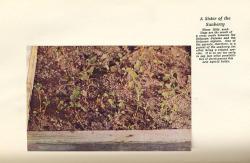
[p. 114]
" … but which has been known for a generation or so in this country, and is sometimes referred to as the "garden huckleberry."
The other is a smaller species, known as Solanum villosum, which was indigenous to Europe, but which is said to have been accidentally introduced in this country a good many years ago from seed mixed in the ballast of a ship. This chanced to be thrown out where it had opportunity to establish itself, near Philadelphia; from which region, after the manner of wandering weeds, it found its way across the country.
The African plant is a strong and heavy fruiting shrub, growing about two feet high on good soil, and spreading to be about three feet in diameter.
It produces large black berries in clusters that stand upright, and that, in the case of some varieties, are nearly as large as cherries. The fruit is not unattractive in appearance, and, as already noted, attempts have been made to introduce it as the "garden huckleberry." But such attempts have met with small measure of success for the very excellent reason that the berry is practically inedible.
I have tested it often, and have always found that one berry is more than any person is willing to eat."
[p. 115]
"I have never known a person who could be induced the second time to attempt to eat this so-called "garden huckleberry," the taste being villainous.
The plant is indeed somewhat closely related to the black nightshade, Solanum nigrum, the American species that is common everywhere, one form of which, known as the stubble-berry, is said to be poisonous, especially if eaten by children, in large quantities when not fully ripe, although fairly palatable when cooked.
The stubble-berry in one or another of its varieties has been used for cooking, in all countries where it grows, when fruit is scarce, chiefly to make pies, as well as for canning. But it is necessary to have the fruit fully ripen; which is often accomplished in cold climates by spreading the berries thinly on shelves and allowing them to mature slowly.
In some regions, as in the Dakotas, the bushes are pulled and hung in the cellar, the fruit being used from time to time as it ripens.
In France the young shoots of this plant are used as a green vegetable, and the plant is even advertised in French catalogs.
The "garden huckleberry," however, differs considerably from the ordinary French stubble-berry, the fruit being much larger in size but far …"
[p. 116]
" … inferior in flavor. It is, however, more nearly free from poisonous qualities, notwithstanding its vile taste.
The differences between the plants themselves are marked, the Solanum guinese being, as already noted, a rather heavy shrub, while Solanum nigrum, though varying considerably, is usually a low spreading and slender plant. It may be said, however, that both of these species, like most other members of the family, show a strong propensity to vary. The black nightshade in particular takes a great variety of forms according to soil and other conditions; each locality having its own variety differing in minor respects from plants of other regions.
I have gone somewhat into detail in this matter, because I wished to establish clearly the standing of the Solanum guinese that was used in my hybridizing experiments, and which thus became one of the parents of the Sunberry; and in particular I wished to make clear that this is a species differing considerably from the better known black nightshade, Solanum nigrum, with which it has been confounded.
The other parent of the Sunberry, already named as Solanum villosum, is a plant differing conspicuously from either of those just described. It is low, and tends to a spreading growth a few … "
[p. 117 illustration]

[p. 118]
" … inches above the ground, never growing upright. The foliage of the plant is pubescent or downy, accounting for its scientific name. In this regard also it is quite different from Solanum nigrum and Solanum guinese.
The fruit grows in clusters of five berries that droop characteristically and always remain greenish in color even when ripe, whereas the fruit of most other Solanums turns black on maturing.
The berries are borne abundantly, and like the tissues of the plant itself they are free from poisonous qualities. The wholesome nature of the plant is attested by the fact that it is eaten freely by herbivorous animals wherever it grows. Rabbits, cattle, and pigs eat it with avidity."
[ SOME OF THE TEXT OMITTED HERE as not relative to the subject of my research : part of page 118 to the end of the chapter ]

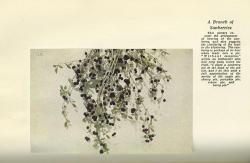
below : high resolution scan of my plant Solanum americanum
American black nightshade
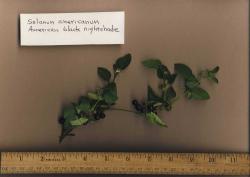
____________________________________________
Atropa belladonna
deadly nightshade / belladonna
⚠ CAUTION: All parts of the plant, especially the fruits, are poisonous ☠
This plant arose spontaneously from the environment. The red fruits are especially attractive to small children, but have to be eaten in fairly large numbers to be deadly. And since they are bitter to some degree, it is unlikely that anyone will consume a fatal dose. This plant is a source of atropine which is a remedy for nerve agents (poisonous gases used by the military) and the juice of the ripe berries was used in times past to dilate the pupils of the eyes (for eye exams).
The vine is growing from a perennial root located at the base of an old rose bush; probably impossible to separate the two.
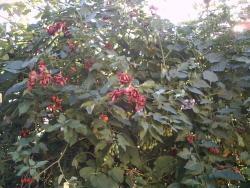

________________________________________________________________

























